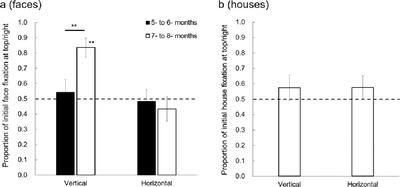Our official English website, www.x-mol.net, welcomes your
feedback! (Note: you will need to create a separate account there.)
Development of upper visual field bias for faces in infants
Developmental Science ( IF 3.1 ) Pub Date : 2022-03-27 , DOI: 10.1111/desc.13262 Shuma Tsurumi 1, 2 , So Kanazawa 3 , Masami K Yamaguchi 1 , Jun-Ichiro Kawahara 4
Developmental Science ( IF 3.1 ) Pub Date : 2022-03-27 , DOI: 10.1111/desc.13262 Shuma Tsurumi 1, 2 , So Kanazawa 3 , Masami K Yamaguchi 1 , Jun-Ichiro Kawahara 4
Affiliation

|
The spatial location of the face and body seen in daily life influences human perception and recognition. This contextual effect of spatial locations suggests that daily experience affects how humans visually process the face and body. However, it remains unclear whether this effect is caused by experience, or innate neural pathways. To address this issue, we examined the development of visual field asymmetry for face processing, in which faces in the upper visual field were processed preferentially compared to the lower visual field. We found that a developmental change occurred between 6 and 7 months. Older infants aged 7–8 months showed bias toward faces in the upper visual field, similar to adults, but younger infants of 5–6 months showed no such visual field bias. Furthermore, older infants preferentially memorized faces in the upper visual field, rather than in the lower visual field. These results suggest that visual field asymmetry is acquired through development, and might be caused by the learning of spatial location in daily experience.
中文翻译:

婴幼儿面部上视场偏倚的发展
日常生活中面部和身体的空间位置影响着人类的感知和识别。这种空间位置的背景效应表明,日常经验会影响人类在视觉上处理面部和身体的方式。然而,尚不清楚这种影响是由经验还是先天神经通路引起的。为了解决这个问题,我们研究了面部处理的视野不对称的发展,其中与下部视野相比,上部视野中的面部被优先处理。我们发现发育变化发生在 6 到 7 个月之间。7-8 个月大的婴儿在上部视野中表现出偏向面部,与成人相似,但 5-6 个月的小婴儿则没有这种视野偏向。此外,年龄较大的婴儿优先记住上部视野中的面孔,而不是下部视野中的面孔。这些结果表明,视野不对称是通过发展获得的,可能是由日常经验中空间位置的学习引起的。
更新日期:2022-03-27
中文翻译:

婴幼儿面部上视场偏倚的发展
日常生活中面部和身体的空间位置影响着人类的感知和识别。这种空间位置的背景效应表明,日常经验会影响人类在视觉上处理面部和身体的方式。然而,尚不清楚这种影响是由经验还是先天神经通路引起的。为了解决这个问题,我们研究了面部处理的视野不对称的发展,其中与下部视野相比,上部视野中的面部被优先处理。我们发现发育变化发生在 6 到 7 个月之间。7-8 个月大的婴儿在上部视野中表现出偏向面部,与成人相似,但 5-6 个月的小婴儿则没有这种视野偏向。此外,年龄较大的婴儿优先记住上部视野中的面孔,而不是下部视野中的面孔。这些结果表明,视野不对称是通过发展获得的,可能是由日常经验中空间位置的学习引起的。










































 京公网安备 11010802027423号
京公网安备 11010802027423号